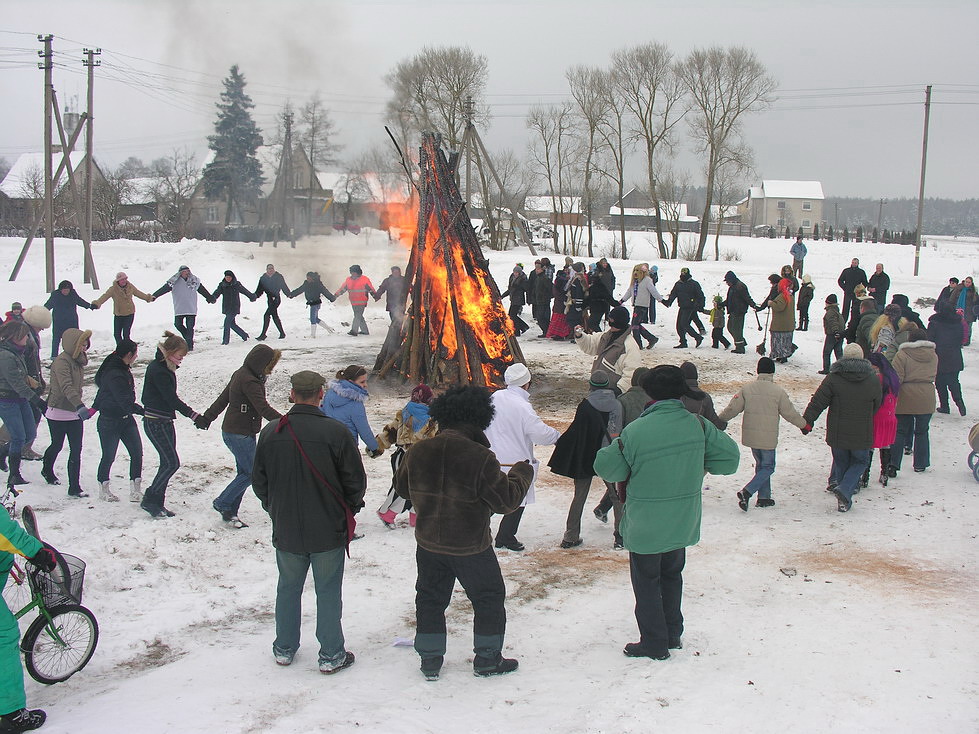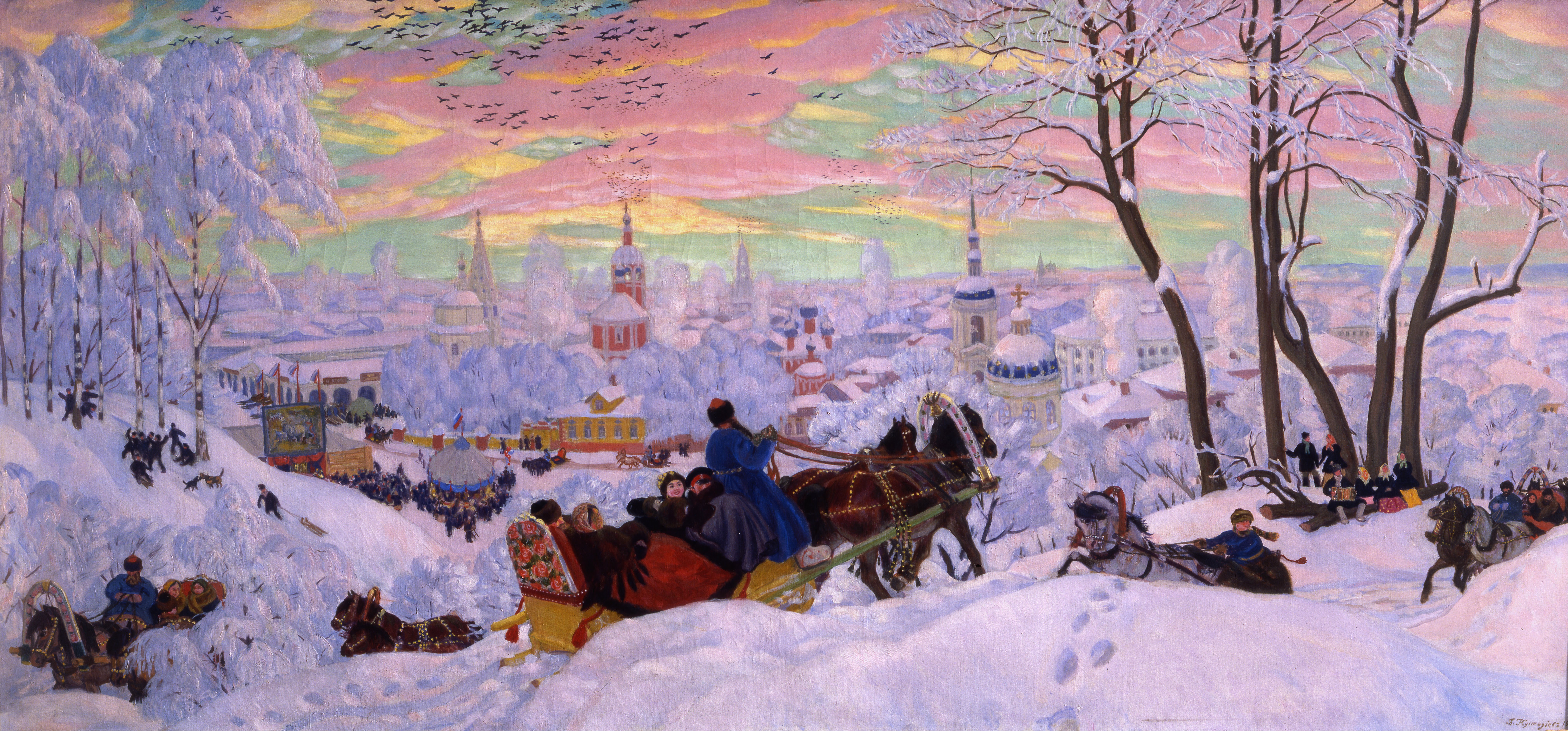|
Užgavėnės
Užgavėnės is an ancient Lithuanian festival that takes place during the seventh week before Easter (Ash Wednesday). The celebration corresponds to Roman Catholic holiday traditions in other parts of the world, such as Mardi Gras, Shrove Tuesday, and Brazilian Carnival, Carnaval. Užgavėnės begins on the night before Ash Wednesday, when an effigy of winter (usually named Marzanna, ''Morė'') is burnt. A major element of the holiday, meant to symbolize the defeat of winter in the Northern Hemisphere, is a staged battle between ''Lašininis'' ("porky") personifying winter and ''Kanapinis'' ("hempen man") personifying spring. Devils, witches, goats, the grim reaper, and other joyful and frightening characters appear in costumes during the celebrations. The participants and masqueraders dance and eat the traditional dish of the holiday - pancakes with a variety of toppings. Užgavėnės is characterized by masked, unrecognizable disguisers walking around the village. Carnival p ... [...More Info...] [...Related Items...] OR: [Wikipedia] [Google] [Baidu] |
Carnivals In Europe
Carnival (known as Shrovetide in certain localities) is a festive season that occurs at the close of the Christian pre-Lenten period, consisting of Quinquagesima or Shrove Sunday, Shrove Monday, and Shrove Tuesday or Mardi Gras. Carnival typically involves public party, celebrations, including events such as parades, public street party, street parties and other entertainments, combining some elements of a circus. Elaborate costumes and masks allow people to set aside their everyday individuality and experience a heightened sense of social unity.Bakhtin, Mikhail. 1984. ''Rabelais and his world''. Translated by H. Iswolsky. Bloomington: Indiana University Press. Original edition, ''Tvorchestvo Fransua Rable i narodnaia kul'tura srednevekov'ia i Renessansa'', 1965. Participants often indulge in excessive consumption of alcohol, meat, and other foods that will be forgone during upcoming Lent. Traditionally, butter, milk, and other animal products were not consumed "excessively", r ... [...More Info...] [...Related Items...] OR: [Wikipedia] [Google] [Baidu] |
Mardi Gras
Mardi Gras (, ; also known as Shrove Tuesday) is the final day of Carnival (also known as Shrovetide or Fastelavn); it thus falls on the day before the beginning of Lent on Ash Wednesday. is French for "Fat Tuesday", referring to it being the last day of consuming rich, fatty foods, most notably red meat, in preparation for the Christian fasting season of Lent, during which such foods are avoided. Related popular practices are associated with Carnival celebrations before the fasting and religious obligations associated with the penitential season of Lent. In countries such as the United Kingdom, Mardi Gras is more usually known as Pancake Day or (traditionally) Shrove Tuesday, derived from the word ''shrive'', meaning "to administer the sacrament of confession to; to absolve". Background During the liturgical season of Lent, some Christians abstain from the consumption of certain foods such as meat, eggs, dairy products, and alcoholic beverages. Most Christian denomin ... [...More Info...] [...Related Items...] OR: [Wikipedia] [Google] [Baidu] |
Shrove Tuesday
Shrove Tuesday (also known as Pancake Tuesday or Pancake Day) is the final day of Shrovetide, which marks the end of the pre-Lenten season. Lent begins the following day with Ash Wednesday. Shrove Tuesday is observed in many Christian state, Christian countries through participating in Confession (religion)#Christianity, confession, the ritual burning of the previous year's Holy Week palms, finalizing one's Lenten sacrifice, as well as eating pancakes and other sweets. Shrove Tuesday is observed by many Christians, including Anglicans, Lutherans, Methodists, Western Orthodox, Western-rite Orthodox Christians, and Roman Catholics, who "make a special point of self-examination, of considering what wrongs they need to repent, and what amendments of life or areas of spiritual growth they especially need to ask God's help in dealing with." This moveable feast is determined by date of Easter, the date of Easter. The expression "Shrove Tuesday" comes from the word ''wikt:en:shrive, shr ... [...More Info...] [...Related Items...] OR: [Wikipedia] [Google] [Baidu] |
Morė
Morė is one of the main effigies and attributes of the traditional Lithuanian folk festival ''Užgavėnės''. It is an artificial woman (''čiūčiala''), stuffed with various materials, who is ultimately burned in a bonfire. Morė is associated with the winter personification as a Slavic goddess Marzanna Morana (in Czech, Slovene, Bosnian, Croatian and Montenegrin), Morena (in Slovak and Macedonian), Mora (in Bulgarian), Mara (in Ukrainian), Morė (in Lithuanian), Marena (in Russian), or Marzanna (in Polish) is a pagan Slavic pantheon, Slavic .... She is burned because once it was believed that it will help to bring spring faster. Participants of the ritual are dancing around the bonfire and shouting "Žiema, žiema, bėk iš kiemo" (Winter, winter, run from the yard). References Lithuanian traditions European folklore Bonfires {{Lithuania-stub ... [...More Info...] [...Related Items...] OR: [Wikipedia] [Google] [Baidu] |
Maslenitsa
Maslenitsa (; ; ; ), also known as Butter Lady, Butter Week, Crepe week, or Cheesefare Week, is an Eastern Slavic religious and folk holiday which has retained a number of elements of Slavic mythology in its ritual. It is celebrated during the last week before Great Lent; that is, the eighth week before Eastern Orthodox Pascha, equivalent to the West's Sexagesima. The date of Maslenitsa changes every year, depending on the date of the celebration of Easter. It corresponds to the Western Christian Carnival, except that Orthodox Lent begins on a Monday instead of a Wednesday, and the Orthodox date of Easter can differ greatly from the Western Christian date. The traditional attributes of the Maslenitsa celebration are the Maslenitsa effigy, sleigh rides, and festivities. Russians bake blini and flatbread, while Belarusians and Ukrainians cook pierogi and syrniki. Traditions According to archeological evidence from the 2nd century AD, Maslenitsa may be the oldest surviving Slavi ... [...More Info...] [...Related Items...] OR: [Wikipedia] [Google] [Baidu] |
Meteņi
Meteņi () or Metenis is an ancient Latvian spring waiting holiday, that ends on Ash Wednesday, which is followed by Lent. Meteņi is celebrated in February or early March, seven weeks before Lieldienas. Origins The Meteņi celebration preserved the ancient traditions of New Year's Eve, because ancient Indo-European people celebrated New Year's Eve in mid-February. This came from the early Latvian word "meti", which meant turn of time, gauge. The original meaning is preserved in the word "laikmets" (era). Lithuanian word "metai" even now means "year". Name in other languages In Livonian populated regions and Riga, this celebration is known as Fastelavn (possibly originating from German ''Fastnacht'' - hunger night). Elsewhere, it is also called Lastavāgs, Aizgavēnis, Miesmetis, Buduļi Eve, and Pie Day. Lithuanians call it ''užgavėnės'', while Estonians call it ''vastlapäev''. To Russians and other Orthodox Christian peoples this festival is known as Maslenitsa ( ... [...More Info...] [...Related Items...] OR: [Wikipedia] [Google] [Baidu] |
Jewish
Jews (, , ), or the Jewish people, are an ethnoreligious group and nation, originating from the Israelites of History of ancient Israel and Judah, ancient Israel and Judah. They also traditionally adhere to Judaism. Jewish ethnicity, religion, and community are highly interrelated, as Judaism is their ethnic religion, though it is not practiced by all ethnic Jews. Despite this, religious Jews regard Gerim, converts to Judaism as members of the Jewish nation, pursuant to the Conversion to Judaism, long-standing conversion process. The Israelites emerged from the pre-existing Canaanite peoples to establish Kingdom of Israel (Samaria), Israel and Kingdom of Judah, Judah in the Southern Levant during the Iron Age.John Day (Old Testament scholar), John Day (2005), ''In Search of Pre-Exilic Israel'', Bloomsbury Publishing, pp. 47.5 [48] 'In this sense, the emergence of ancient Israel is viewed not as the cause of the demise of Canaanite culture but as its upshot'. Originally, J ... [...More Info...] [...Related Items...] OR: [Wikipedia] [Google] [Baidu] |
February Observances
February is the second month of the year in the Julian and Gregorian calendars. The month has 28 days in common years and 29 in leap years, with the 29th day being called the ''leap day''. February is the third and last month of meteorological winter in the Northern Hemisphere. In the Southern Hemisphere, February is the third and last month of meteorological summer, being the seasonal equivalent of August in the Northern Hemisphere. Pronunciation "February" can be pronounced in several different ways. The beginning of the word is commonly pronounced either as or ; many people drop the first "r", replacing it with , as if it were spelled "Febuary". This comes about by analogy with "January" (), as well as by a dissimilation effect whereby having two "r"s close to each other causes one to change. The ending of the word is pronounced in the US and in the UK. History The Roman month was named after the Latin term , which means "purification", via the purific ... [...More Info...] [...Related Items...] OR: [Wikipedia] [Google] [Baidu] |
Festivals In Lithuania
A festival is an event celebrated by a community and centering on some characteristic aspect or aspects of that community and its religion or cultures. It is often marked as a local or national holiday, mela, or eid. A festival constitutes typical cases of glocalization, as well as the high culture-low culture interrelationship. Next to religion and folklore, a significant origin is agricultural. Food is such a vital resource that many festivals are associated with harvest time. Religious commemoration and thanksgiving for good harvests are blended in events that take place in autumn, such as Halloween in the northern hemisphere and Easter in the southern. Festivals often serve to fulfill specific communal purposes, especially in regard to commemoration or thanking to the gods, goddesses or saints: they are called patronal festivals. They may also provide entertainment, which was particularly important to local communities before the advent of mass-produced entertainment. ... [...More Info...] [...Related Items...] OR: [Wikipedia] [Google] [Baidu] |
Visuotinė Lietuvių Enciklopedija
The ''Visuotinė lietuvių enciklopedija'' or VLE () is a 25-volume universal Lithuanian-language encyclopedia published by the Science and Encyclopaedia Publishing Institute from 2001 to 2014. VLE is the first published universal encyclopedia in post-Soviet Lithuania (it replaces the former ''Lietuviškoji Tarybinė Enciklopedija'' which was published in thirteen volumes from 1976 to 1985). The last volume, XXV, was published in July 2014. An additional volume of updates, error corrections, and indexes was published in 2015. The encyclopedia's twenty-five volumes contain nearly 122,000 articles and about 25,000 illustrations. Since June 2017, VLE is published as an online encyclopedia being updated to present day. Description VLE is an encyclopedia published in Lithuanian; therefore, it focuses on Lithuania, Lithuanians and Lithuanian topics (Lithuanian personalities, organizations, language, culture, national activities). These articles make up about 20–25% of all articles ... [...More Info...] [...Related Items...] OR: [Wikipedia] [Google] [Baidu] |
Aukštaitija
Aukštaitija (; literally ''Highland'' or ''Upland'') is the name of one of five ethnographic regions of Lithuania. The name comes from the fact that the lands are in the upper basin of the Nemunas, as opposed to the Lowlands that begin from Šiauliai westward. Although Kaunas is surrounded by Aukštaitija, the city itself is not considered to be a part of any ethnographic region in most cases. Geography Aukštaitija is in the northeast part of Lithuania and also encompasses a small part of Latvia and Belarus. The largest city located entirely within this region, Panevėžys, is considered to be the capital, though not in a political sense. Sometimes Utena is regarded as a symbolical capital. The largest cities by population are: * Panevėžys – 84,587 * Jonava – 26,423 * Utena – 25,397 * Kėdainiai – 22,677 * Ukmergė – 20,154 * Visaginas – 18,024 * Radviliškis – 15,161 The region has many lakes, mainly on the eastern side. Subdivisions History Historic ... [...More Info...] [...Related Items...] OR: [Wikipedia] [Google] [Baidu] |




